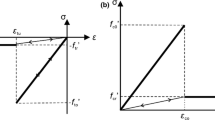Hydraulic fracturing technology has become an effective technical method of developing tight oil reservoirs, such as an oilfield in Mahu, China. However, numerical simulation of the actual fracture seam network remains problematic. In this paper, we have simulated hydraulic fractures in the Urho Group of the Mahu target layer and analyzed the characterization of the rock mechanics parameters. The results show that Young’s modulus of the Wuerhe domain ranges between 18 and 58.5 GPa, with an average of 32.4 Gpa, the Poisson’s ratio is between 0.21 and 0.38, with an average of 0.31, the brittleness index is between 21.0 and 89.0, with an average of 44.3, and the hydraulic fracturing can form a multi-branch crack modification. The designed direction of horizontal wells in the area is north-south, and the horizontal stress difference is between 4.2 and 9.8 MPa, which facilitates easy fracturing of the reservoir and reforming of a complex seam network. Simulation of the artificial seam network helps to optimize the reasonable parameters of fracturing and the development parameters of horizontal wells in the Mahu 1 well area.





Similar content being viewed by others
References
Y. Zhang, Y. Yan, and L. Li, “Status and prospect of horizontal well fracturing technology,” Chem. Design Commun., 46(06), 278-279 (2020).
M. Xue, Y. Cheng, C. Yan, Y. Li, Q. Li, and S. Han, “Optimization of multistage hydraulic fracturing methods for horizontal wells in shale gas reservoirs,” Daqing Pet. Geol. Dev., 4, 1-8 (2020).
X. He, J. Ma, G. Liu, S. Shi, J. You, and J. Wu, “Rock mechanics analysis and fracture network evaluation of conglomerate reservoir in Mahu oilfield,” Xinjiang Pet. Geol., 40(06), 701-707 (2019).
R. Xue, J. Guo, Z. Zhao, G. Zhou, and X. Meng, “Numerical simulation of horizontal well fracture propagation in shale reservoir in Jiyang depression,” J. Southwest Pet. Univ. (Nat. Sci. Ed.), 41(02), 84-96 (2019).
L. Ren, R. Lin, J. Zhao, and L. Wu, “Optimal design of fracturing cluster spacing for shale gas horizontal wells based on optimal SRV,” Nat. Gas Ind., 37(04), 69-79 (2017).
X. Wang, L. Liang, L. Zhao, X. Liu, Z. Qin, and W. Li, “Rock mechanical properties and fracturing evaluation of oilbearing shale of Lucaogou formation in Jimusaer sag, Junggar basin,” Pet. Nat. Gas Geol., 40(03), 661-668 (2019).
X. Xu, Y. Zhai, M. Liu, P. Zhou, Z. Wang, et al., “Rock brittleness analysis and application research of complex reservoir,” LOG Technol., 39(04), 486-490 (2015).
P. Tang, “Experimental study on the brittleness of glutenite reservoir in Songbei tight gas reservoir,” Pet. Geol. Recov. Fact., 26(06), 46-52 (2019).
J. Fu, H. Li, Z. Sun, G. Wang, and X. Luo, “In-situ stress directional logging identification and main controlling factors of glutenite reservoir in Mabei area,” Pet. Nat. Gas Geol., 36(04), 605-611 (2015).
K. Xu, J. Tian, H. Yang, H. Zhang, Z. Wang, F. Yuan, et al., “Prediction and application of current in-situ stress field in deep tight sandstone reservoir: a case study of Keshen 10 gas reservoir in Kelasu structural belt, Tarim Basin,” J. Chin. Univ. Min. Technol., 49(04), 708-720 (2020).
Z. Tang, Q. Li, and H. Yin, “Calculation of maximum horizontal in-situ stress by using wellbore failure information of inclined shaft,” Fault Block Oil Gas Field, 24(05), 709-713 (2017).
Z. Wang, B. Lin, H. Yu, S. Shi, and X. Kou, “In-situ stress characteristics of sand conglomerate reservoir in Badaowan formation of block 7 of Karamay oilfield,” Pet. Geol. Xinjiang, 41(03), 314-320 (2020).
Acknowledgments
This work was supported by “Tight oil development demonstration project in Junggar Basin,” the Major National Science and Technology project (Grant No. 2017ZX05070), Xinjiang Conglomerate Reservoir Laboratory Open Project (Grant No. 2019D04008), CNPC China University of Petroleum (Beijing) strategic cooperation project (Grant No. ZLZX2020-01), and Science and Technology Major Project of CNPC (No. 2017E-0405).
Author information
Authors and Affiliations
Corresponding author
Additional information
Translated from Khimiya i Tekhnologiya Topliv i Masel, No. 4, pp. 77–81, July–August, 2021.
Rights and permissions
About this article
Cite this article
Huo, J., Kong, C., Jiang, Q. et al. Fracture Network Simulation and Mechanical Characteristics Analysis of Glutenite. Chem Technol Fuels Oils 57, 665–671 (2021). https://doi.org/10.1007/s10553-021-01291-2
Published:
Issue Date:
DOI: https://doi.org/10.1007/s10553-021-01291-2




